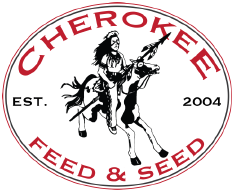 Earning More for Beef Calves this Fall: With a well-executed weaning and preconditioning plan, you can stay in front of keeping your herd and operation healthy. Cherokee Feed and Seed offer free on-farm consultations with our Livestock Production Specialist to go over your weaning and preconditioning program.
Earning More for Beef Calves this Fall: With a well-executed weaning and preconditioning plan, you can stay in front of keeping your herd and operation healthy. Cherokee Feed and Seed offer free on-farm consultations with our Livestock Production Specialist to go over your weaning and preconditioning program.
According to Brett Terhaar, DVM, beef technical consultant for Elanco Animal Health, the buzz around cattle prices is palpable. “We knew we were going to see value in our cattle at the sale barns this season. But, watching fall calving cows sell for $3,200 apiece was pretty staggering,” he says, recounting his recent trip to Nebraska. With a decrease in cow numbers and strong beef demand, beef cattle prices are hitting record-breaking highs.
While it may seem like simple napkin math to put fewer dollars toward preconditioning your calves, Terhaar urges producers to do what’s right by their calves and resist the urge to cut corners.
“The temptation is there to take these calves right off the cow and send them to the sale barn and cash in,” he says. “We know that weaning and preconditioning for around 45 days on the farm or ranch of origin is the most important factor in ensuring a calf’s health as it moves through the production system. During those 45 days, calves tend to gain weight at a rate of up to two pounds per day. This leads to more profits for the producer.”
At minimum, Terhaar says good animal husbandry and management practices, a solid nutrition program and health protocols that include vaccination for key cattle diseases are critical.
PRECONDITIONING:
“Preconditioning is a holistic approach,” he explained. “A vaccination program does not replace good management practices. Vaccines can often be blamed for cattle health issues on the farm. But, the truth is they are not the end-all, be-all. One of the first things a veterinarian should look to identify when respiratory outbreaks strike is poor management practices that can contribute to illness.”
ANIMAL HUSBANDRY IS THE RIGHT THING TO DO
Ensure calves have comfortable living conditions including clean, dry bedding, access to adequate nutrition and clean, fresh water. Nutrition continues to be an important aspect in overall health and priming a healthy immune system that may lead to a better vaccine response. Stress can negatively impact cattle’s immune systems as well. Minimize stress by shortening transportation time. Reduce commingling and use low-stress handling techniques as cattle are introduced to new environments or experiences.
VACCINATION PROGRAMS HELP TO PREVENT KEY DISEASES
There is no cookie-cutter approach to a vaccination protocol. Every operation will have unique requirements based on disease pressure and individual herd goals. Consulting with your herd veterinarian is important when designing herd health and vaccination protocols. Generally, cattle in a preconditioning program should be vaccinated against the following:
- Respiratory viruses – commonly available
in modified-live (MLV) 5-way viral vaccine –
including bovine viral diarrhea (BVD) Types
1 and 2, infectious bovine rhinotracheitis
(IBR), bovine parainfluenza3 (PI3) and bovine
respiratory syncytial virus (BRSV) - 7-way clostridial (blackleg)
- Mannheimia haemolytica
(respiratory bacteria) - Others: Pasteurella multocida and
Histophilus somni (respiratory bacteria)
Vaccine storage and handling is also crucial. Always check the expiration dates on vaccine products. Follow label directions and be sure to keep vaccines refrigerated at proper temperature until use. Keep all MLV vaccines out of sunlight.
ANTIBIOTICS FOR BRD
“If you’re having BRD problems in the calves, post-weaning, you may have management issues to address,” he emphasized. “An unfortunate scenario can occur where you’ve followed your vaccination program to a T, applied best management practices, your calves are doing great, you pick your weaning date and a few days later there’s a major change in weather. It’s now 40 degrees and drizzling for three days straight. Guess what? A few of your calves are going to experience some respiratory disease from that weather change. This is where I recommend producers are prepared and have two antibiotics of different classes on their shelves.” Terhaar also recommends producers spend some time in both the morning and afternoon observing calves for any signs of respiratory disease.
IMPLANTING MAKES CENTS
A critical goal of preconditioning is adding pounds. This can be accomplished with one of the most profitable management tools available, implants, consistently helping calves gain 15 to 40 pounds.
“With a single-dose implant program, we can see an extra two-tenths of a pound per day3 for an investment of only $2. That might not sound like much weight, but say you have your calves for 100 days, that equates to an additional 20 pounds. With calf prices at $3 per pound, that’s an extra $60 in your pocket. It’s a significant return on investment that many producers aren’t always taking advantage of,” Terhaar explains.
RECORD KEEPING GIVES CONFIDENCE
If you’re investing in a preconditioning program, keeping accurate records is key. Providing documentation that calves have been vaccinated against all the key disease pathogens that threaten calf health gives buyers confidence and pride in their purchase. “All in all, when we consider the current market conditions, there’s tremendous potential waiting in your pastures right now,” says Terhaar. “There’s no better time than now to invest in growing healthier calves. With a well-executed plan, you can ensure you’re staying one step ahead and keeping both your animals and your operation healthy.”
